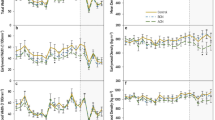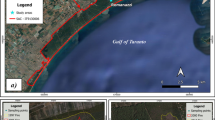Abstract
The needle trace method was used to study retrospectively the long-term latitudinal variation in needle retention in Scots pine (Pinus sylvestris L.) in Finland. The mean annual summer needle retention (ANR) along the main stem varied from 3.4 to 6.0 needle sets during the period 1957–1991. The lowest values were observed in southern and the highest in northern Finland. The length of the growing season, expressed as the thermal sum (threshold value +5 °C), was negatively correlated with the mean ANR (r=-0.96). The geographical needle retention pattern (NRP) for the period 1957–1991 showed a clearly increasing trend from 1957 to 1969 (southern Finland) and to 1975 (northern Finland); thereafter, the NRP tended to decrease close to its minimum value recorded in 1991. The general level of the NRP was approximately 5.0 needle sets in northern Finland and 3.5–4.0 needle sets in southern Finland. The NRP, with its 6–12 year cycle for southern Finland, was clearly periodical. Differences in the NRP among the ten stands in southern Finland were small, whereas the said periodicity was missing and the differences were high among the stands in northern Finland. The results indicate that variation in the number of needle sets, viz. defoliation of pines, is a normal phenomenon. The role of net carbon assimilation as a regulator of the number of needle sets is discussed.
Similar content being viewed by others
References
Aalto T, Jalkanen R (1994a) NTM. The needle trace method. Instructions, version 3. Mimeograph, The Finnish Forest Research Institute, Rovaniemi Research Station, Rovaniemi
Aalto T, Jalkanen R (1994b) Computation program for the needle-trace method. NTMENG, version 2.1 Mimeograph, The Finnish Forest Research Institute, Rovaniemi Research Station, Rovaniemi
Andersson G (1905) Shoot dieback on Scots pine in spring 1903 in northern Sweden (in Swedish) Skogsvför Tidskr 3: 449–477
Derome J, Lindroos A-J, Niska K, Välikangas P (1992) Bulk deposition in Finnish Lapland during July 1990 to June 1991 (in Finnish). In: Kauhanen H, Varmola M (eds) The Lapland forest damage project. Interim Report. Metsäntutkimuslaitoksen Tiedonantoja 413: 39–48
Ewers FW, Schmid R (1981) Longevity of needle fascicle of Pinus longaeva (bristlecone pine) and other North American pines. Oecologia 51: 107–115
Flower-Ellis JGK (1985) Litterfall in an age series of Scots pine stands: summary of results for the period 1973–1983. In: Lindroth A (ed) Climate, photosynthesis and litterfall in pine forest on sandy soil — basic ecological measurement at Jädraås. Swedish University of Agricultural Sciences, Department of Ecology and Environmental Research, Uppsala, Report 19: pp75–94
Huttunen S, Tikkinen S, Bäck J, Lamppu J, Manninen S (1992) Sulphur dioxide concentrations in the air, tree injury symptoms and sulphur accumulation in needles and Bryoria species (in Finnish). In: Kauhanen H, Varmola M (eds) The Lapland forest damage project. Interim Report. Metsäntutkimuslaitoksen Tiedonantoja 413: 136–141
Innes J (1988) Forest health surveys: problems in assessing observer objectivity. Can J For Res 18: 560–565
Jalkanen R (1985) The occurrence and importance of Lophodermella sulcigena and Hendersonia acicola on Scots pine. Karstenia 25: 53–61
Jalkanen R (1986) Lophodermella sulcigena on Scots pine in Finland. Commun Inst For Fenn 136
Jalkanen R (1990) Injuries in nature after the Winter 1986–87 in Lapland. In: Varmola M, Palviainen P (eds) Forest health in Lapland (in Finnish) Metsäntutkimuslaitoksen Tiedonantoja 347: 31–33
Jalkanen R (1993) Defoliation of pines caused by injury to roots resulting from low temperatures. In: Jalkanen R, Aalto T, Lahti M-L (eds) Forest pathological research in northern forests with a special reference to abiotic stress factors. Extended SNS meeting in forest pathology in Lapland, Finland, 3–7 August 1992. Metsäntutkimuslaitoksen Tiedonantoja 451: 77–88
Jalkanen R (1995) Needle retention chronology along a pollution gradient. In: Dean JS, Meko DM, Swetnam TW (eds) Tree rings, environment and humanity. Radiocarbon (in press)
Jalkanen R, Kurkela T (1990) Needle retention, age, shedding and budget, and growth of Scots pine between 1865 and 1988. In: Kauppi P, Anttila P, Kenttämies K (eds) Acidification in Finland. Springer, Berlin Heidelberg New York, pp 691–697
Jalkanen R, Kurkela T (1992) VB-method for the determination of pine defoliation in the past. Proc. Tree rings and climate, Ystad, Sweden, 3–9 September 1990. Lundqua Rep 34: 153–157
Jalkanen R, Nikula A (1993) Forest damage in northern Finland in 1992. In: Jalkanen R, Aalto T, Lahti M-L (eds) Forest pathological research in northern forests with a special reference to abiotic stress factors. Extended SNS meeting in forest pathology in Lapland, Finland, 3–7 August 1992. Metsäntutkimuslaitoksen Tiedonantoja 451: 30–35
Jalkanen R, Aalto T, Innes J, Kurkela T, Townsend I (1994a) Needle retention and needle loss of Scots pine in recent decades at Thetford and Alice Holt, England. Can J For Res 24: 863–867
Jalkanen R, Aalto T, Kurkela T (1994b) The use of needle-trace method (NTM) in retrospectively detecting Lophodermella needle-cast epidemic. Eur J For Path 24: 376–385
Jalkanen R, Aalto T, Derome K, Niska K, Ritari A (1995) Needle loss in Lapland. Factors affecting the 1987 needle loss in northern Finland. Final report (in Finnish) Metsäntutkimuslaitoksen Tiedonantoja 544
Juutinen P, Varama M (1986) Occurrence of the European pine sawfly (Neodiprion sertifer) in Finland during 1966–83 (in Finnish). Folia For 662
Karhu M, Huttunen S (1986) Erosion effects of air pollution on needle surfaces. Water Air Soil Pollut 31: 417–423
Kouki J, Hokkanen T (1992) Long-term needle litterfall of a Scots pine (Pinus sylvestris) stand: relation to temperature factors. Oecologia 89: 176–181
Kurkela T, Jalkanen R (1990) Revealing past needle retention in Pinus spp. Scand J For Res 5: 481–485
Miller PR, van Doren RE (1981) Ponderosa and Jeffrey pine foliage retention indicates ozone dose response. In: Proceedings of the symposium on the dynamics and management of Mediterranean-type ecosystems. San Diego, California. USDA For Serv
Ojansuu R, Henttonen H (1983) Estimation of the local values of monthly mean temperature, effective temperature sum and precipitation sum from the measurements made by the Finnish Meteorological Office (in Finnish). Silva Fenn 17: 143–160
Pravdin LF (1964) The common pine (in Russian) Ispatelstvo Nauka, Moskva
Ritari A (1990) Exceptional Winter 1986–87 and frost injuries in northern Finland. In: Varmola M, Palviainen P (eds) Forest health in Lapland (in Finnish). Metsäntutkimuslaitoksen Tiedonantoja 347: 47–57
Saarenmaa H (1987) Insect attack and blue stain in windthrown trees in Lapland 1983–86 (in Finnish). Folia For 696
Salemaa M, Jukola-Sulonen E-L, Lindgren M (1991) Forest condition in Finland, 1986–1990. Silva Fenn 25: 147–175
Skuhravy V (1990) Das Vorhandensein von Nadeln an den Trieben der gemeinen Kiefer, Pinus sylvestris L. als Indikator für den Grad des Umwelteinflusses. Anz Schädlingsk Pflanzen Umweltschutz 63: 145–147
Systat (1992) SYSTAT for Windows: Statistics, Version 5 Edition. Systat, Evanston, ILL.
Tikkanen E, Mikkola K (1991) The Lapland forest damage project: multidisciplinary cooperation in environmental sciences. In: Tikkanen E, Varmola M (eds) Research into forest damage connected with air pollution in Finnish Lapland and the Kola peninsula of the U. S. S. R. Metsäntutkimuslaitoksen Tiedonantoja 373: 20–34
Tuovinen J-P, Kangas L, Nordlund G (1990) Model calculations of sulphur and nitrogen deposition in Finland. In: Kauppi P, Anttila P, Kenttämies K (eds) Acidification in Finland. Springer, Berlin Heidelberg New York, pp 167–197
Tuovinen J-P, Laurila T, Lättilä H, Ryaboshapko A, Brukhanov P, Korolev S (1993) Impact of the sulphur dioxide sources in the Kola peninsula on air quality in northernmost Europe. Atmos Pollut, Series A 27: 1379–1395
Weidman RH (1939) Evidences of racial influence in a 25-year test of ponderosa pine. J Agric Res 59: 855–887
Zederbauer E (1916) Beiträge zur Biologie der Waldbäume. Cbl Ges Forstw 42: 233–247
Author information
Authors and Affiliations
Rights and permissions
About this article
Cite this article
Jalkanen, R., Aalto, T. & Kurkela, T. Development of needle retention in Scots pine (Pinus sylvestris) in 1957–1991 in northern and southern Finland. Trees 10, 125–133 (1995). https://doi.org/10.1007/BF00192193
Received:
Accepted:
Issue Date:
DOI: https://doi.org/10.1007/BF00192193




